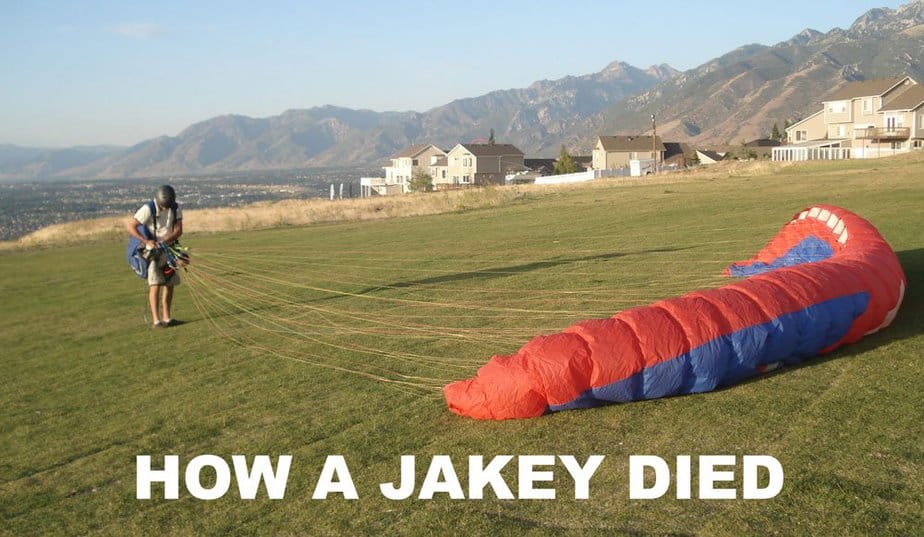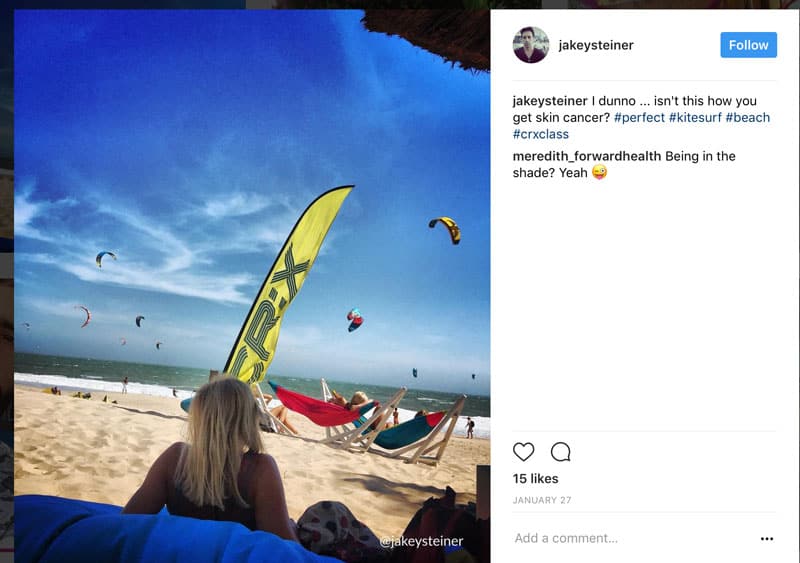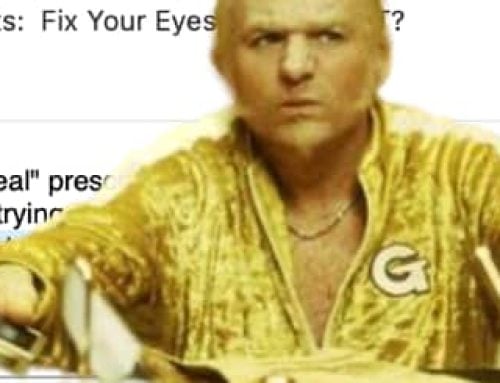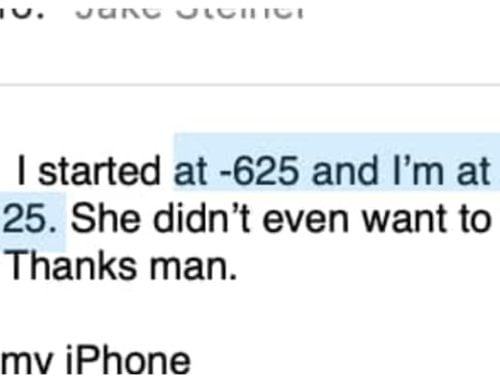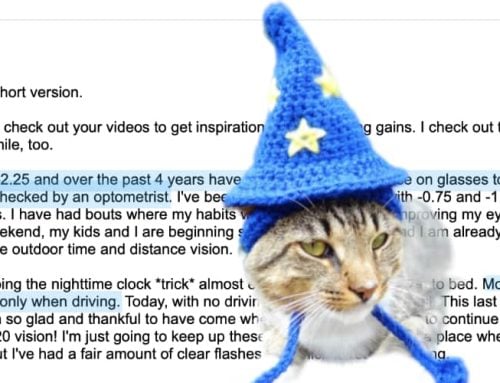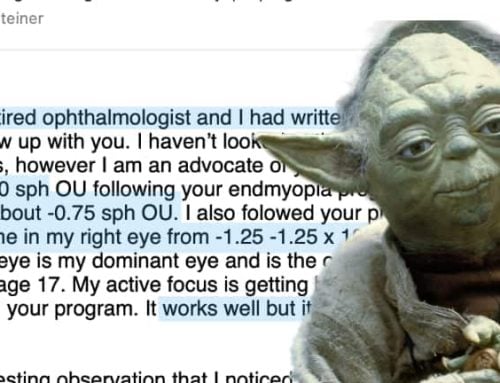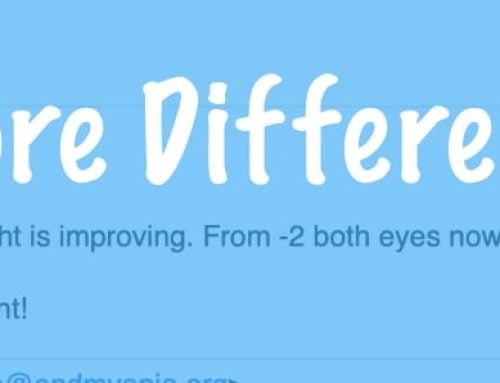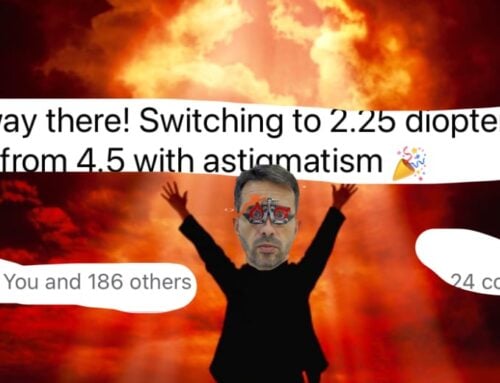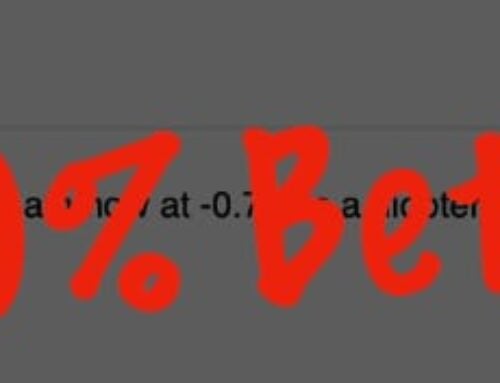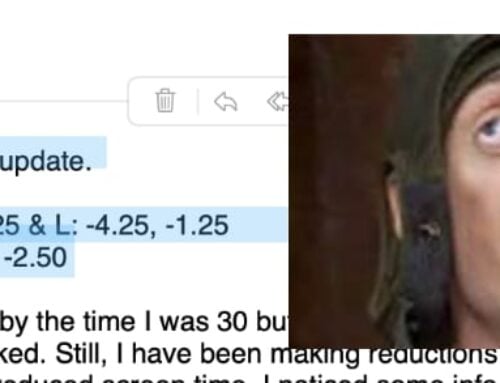Q&A for those with low myopia and advanced level endmyopia students.
There’s a brilliant thread in the support forum right now (many brilliant threads, but this one really gets me).
If you’re in BackTo20/20, or even if you’re going DIY with just the blog, you might love this one, too. Todd has been keeping his progress all in one thread, reducing astigmatism, working on equalizing, and running through an interesting scenario of travel and home-habits time.
He’s right at that point where you can really start reducing artificial focal plane dependence, which is a great, fantastic part of the process.
While the theoretical approach used by us here is quite simple (strain + stimulus management), the real genius is in the details. High myopia is one side of the puzzle, with finding a balance between glasses and contact lens use, getting good habits, getting out of that high artificial focal plane territory. You’re basically just grinding it out at that level, one diopter after the next.
And then you get to low myopia, where there’s a lot of finesse (and fun) in working between lens correction and natural focal plane. Here you have the last tweaks to simplifying your focal plane correction (eliminating diopter ratio and astigmatism) and starting to slowly move away from artificial focal plane dependence altogether.
Real guru territory this, and super fun. Low myopia FTW!
Transitioning Low Myopia Progress
Here’s one of Todd’s updates in the thread:
Back from the bush, and finding the flow with the program again (on #70 now). Centimeter results were a centimeter down when getting back (June 14), but my last three day centimeter testing (6/22-24) was my highest recording yet (R 38.6, L 47.6, B 48.7). The Snellen was good too, being at 20/30 for each eye. I’m trying to take advantage of my new Normalized (R -2.00/L -1.50) still being fresh (per installment #53) by pulling focus when I put them on, but at the same time I want to honor the suggestion to let the eyes rest (per #64) from time to time. I do the No Prescription Day once/week, and this seems restful to my eyes. I am also experimenting with the Medium Distance focal plane when I’m inside. My eyes seem to like being without prescription rather than with Differential for Medium Distance. Normalized work well outside, when I’m not focusing on getting periphery vision exposure with the natural outdoor shaded light. The new Normalized are going to work, I think. Also, I want to say that I like the What Can I See Game from installment #41. Something about doing that my eyesight really likes.
I’d like to comment on how my eyes/eyelids feel when doing the Sniper Stare (#65): they begin to burn a bit after only a few seconds, and then I can’t help but blink. This happens most of the time. But, there are times when I can get to 10-15 seconds. I’m thinking it has to do with light sensitivity, or eye dryness. I’m going to experiment further to find out, but if you have any suggestions, I’m all ears! I like the potential of the Sniper Stare and I’d like to continue with it as long as it’s not too straining in the end. Thanks, Jake!
See what I mean?
If you have BackTo20/20 access I encourage you to read the whole thread, it’s really quite full of excellent details.
Here are my follow-up comments to Todd’s update:
That’s great, Todd! Definitely how it should go – when getting back to the established routines after that time in novel environments, getting a boost in centimeters.
Very nice too, 20/30 with the -2. Milestone! Natural focal plane is definitely a good one at this point, reading without glasses, middle distance, finding a nice balance between the additional clarity with the -2 (and some active focus with it), and no correction. Important here is to realize that sometimes it’s better to use glasses when you’re not going to use any active focus or otherwise be in a bit of passive blur. Keep your visual cortex primed to expect clarity, to not get blur adaption – this is a bit of a personal experiment though, finding the balance.
Sniper stare, take it easy with it. Best on relaxed days, being well hydrated, realizing that you want to leverage the stimulus by not going too far with it. It’s a bit like the progressive overload principle in weight lifting, insofar as that you want to use just enough of the challenge to push yourself a little bit further periodically.
-2, though. That’s so close to a lot less need for glasses. Great spot to be in. Keep me posted on your progress!
If you’ve ever gotten into an athletic endeavor, you already have a good taste for this type of vision improvement project.
Living A Life Of Real Adventures
Screens are insidious. They tempt us to replace our own adventures, with fake, simulated, online ones.
Remember back when you just started out (with any physical type of new adventure). Whether it’s martial arts, or rock climbing, or weight lifting, or ice skating or anything else, your body and your brain went through a whole range of learning processes and adaptations. Hopefully you’ve had this sort of experience before – and if not, then vision improvement can be the first one, too. It’s incredibly exciting to realize this power you have to change your physical self to a great extent. You can become faster, bigger (or smaller!), more agile, more skilled, in a way that’s almost like a superhero movie. Yes, not all CGI and immediate, but nonetheless you can induce a dramatic and very satisfying improvement to your own self and your experience of the world around you.
It’s somewhat addicting, even. If you follow me regularly, you might know that even though I’m clumsy and uncoordinated (and pretty much scared by anything), I find a new physical challenge on a semi regular basis.
Most recently it was kitesurfing. Mind blowing, amazing experience. Going from being scared and drinking a lot of ocean water, to eventually cruising over the waves, on your own power (and the wind), like some kind of Poseidon of the seas. Brilliant and if you have the chance, I highly recommend it.
Vision improvement can be a gateway experience to all sorts of adventure.
(Jakey’s semi secret Instagram)
I do wish I had a way to have you really know me in person.
You Don’t Have To Be A Super Athlete
I always had the worst grades in gym in school, to this day I’m the least of a natural athlete you can imagine. Think of a very Jewish kind of accountant type, all OCD and full of phobias. That’s your darling eye guru. And yet you’d never know it meeting one Jakenheimer fleetingly, as it seems as though it’s all about risky adrenaline sports and adventures. You could attribute a lot of that to improving eyesight, to slowly dipping a toe into one experience to the next, avoiding screens, looking for ways to be outside, and over time getting more and more excited to find the next way to use the physical body to have amazing experiences. And so many ways to extend your body’s abilities with incredible toys!
Just consider it for a moment. It’s like real life bat suits that you can buy for some many mind blowing superpowers. Whether it’s kite surfing (really, you can skim over the ocean surface like a mythical God creature!) or paragliding (flying for hours on end, no motors, like a bird!)
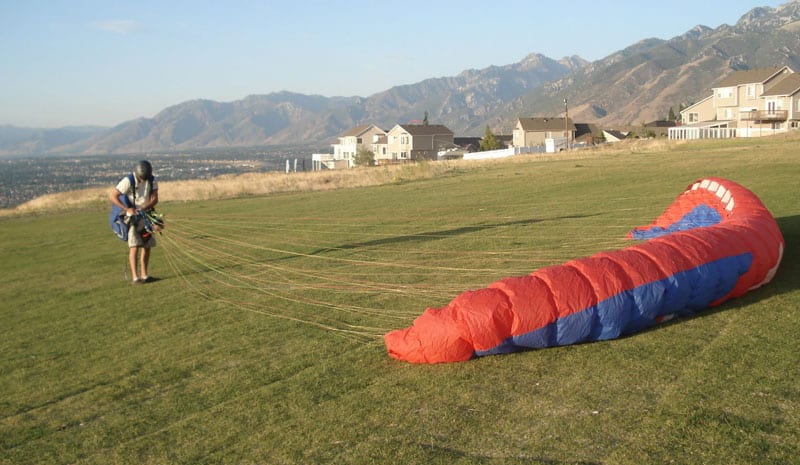
Jakey, never doing smart things.
And great natural eyesight, which you can get right here.
That’s all. I get carried away, whenever we get those 2 diopter milestone reports. Get out there and live your life, not in front of fake-life surrogacy screens and simulated experiences! ;)
Cheers,
-Jake

